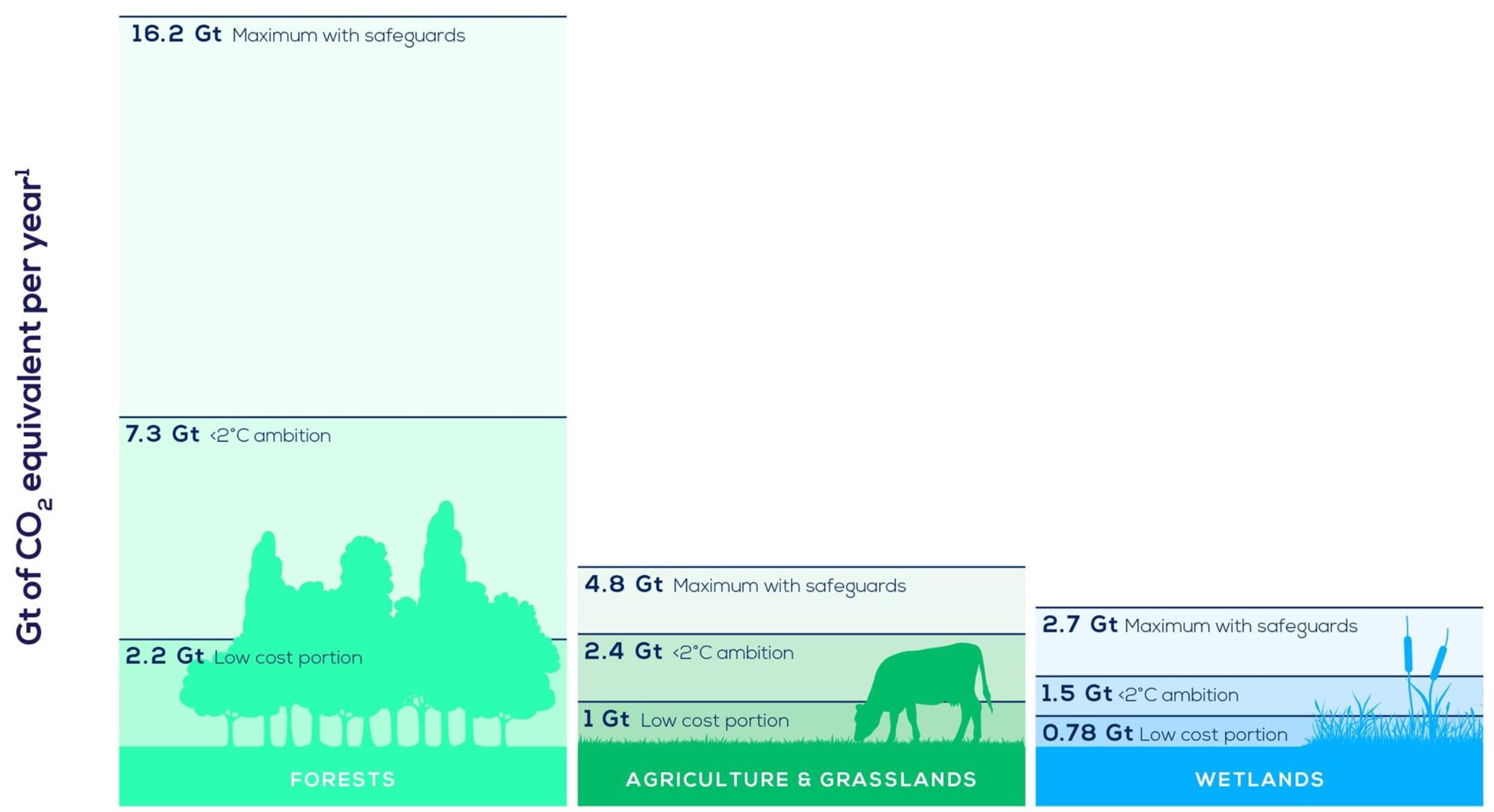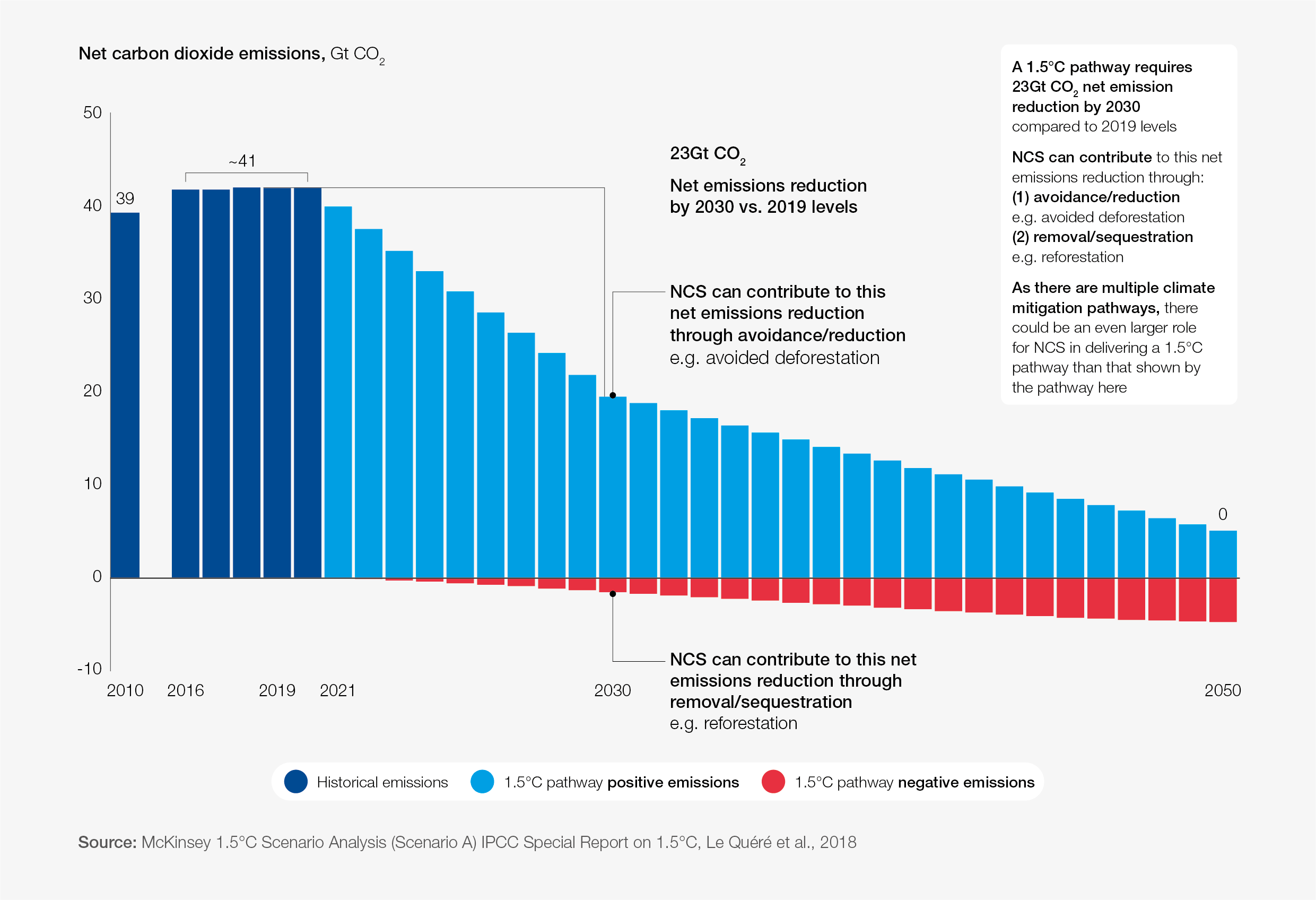These 7 advances in natural climate solutions are gaining momentum

Preventing deforestation is one of the most cost-effective means of abating carbon emissions.
Image: Unsplash.
Izabella Teixeira
Former Minister of Environment for Brazil , Co-Chair of the International Resource PanelStay up to date:
Future of the Environment
- Public-private sector needs to build confidence in natural climate solutions (NCS) to achieve climate goals.
- Nature and Net Zero report, from the World Economic Forum and McKinsey, outlines the agenda to achieve emissions reductions.
- We highlight this year's top seven developments in NCS which could accelerate this pathway.
Natural climate solutions (NCS) could provide up to one-third of the emissions reductions needed to achieve a 1.5-degree pathway. For this to happen, stakeholders in the public and private sectors will need confidence that NCS can be effective in addressing local needs as well as global challenges. Technical and conceptual hurdles that presently limit uptake of NCS.
This agenda mapped out in the final Nature and Net Zero report from the World Economic Forum and McKinsey, won’t be easy to execute—but change is accelerating. The year 2021 has seen several noteworthy developments that could help speed the growth of NCS.
1. Blueprint for market mechanisms took shape
In January, the Taskforce on Scaling Voluntary Carbon Markets (TSVCM) released a blueprint for a global market for voluntary carbon credits. A global voluntary carbon market is needed to facilitate the flow of capital toward a wide variety of projects, including NCS projects, which accounted for about 40% of the voluntary carbon credits that were purchased and retired in 2020. On September 21, as outlined in its January blueprint, the TSVCM launched a governance body to establish a global benchmark for high quality carbon credits and carry forward its mission to scale high integrity voluntary carbon markets. The board of the new governance body has independent actors, including NGO and civil society representatives, in the majority, while also bringing in invaluable commercial expertise from the global carbon value chain.
2. Call for integrity in voluntary carbon markets was made
To contribute to the building momentum, the Voluntary Carbon Markets Integrity Initiative (VCMI) was launched in July to bring transparency and rigour to net-zero and carbon neutral claims and ensure voluntary carbon markets fulfil their true potential. As companies and countries strive to meet climate targets, there is a greater need for consensus or agreement on assurance and integrity. Convening a broad group of stakeholders, VCMI intends to develop high integrity guidance for buyers of carbon credits, including climate claims by businesses. The VCMI drafted a Consultation Report drawing on initial discussions with a diverse range of stakeholders and welcomes feedback on the content by September 2021.
3. New carbon-credit exchange was announced
Because voluntary carbon markets are underdeveloped, much trading of credits takes place in direct transactions between buyers and sellers. Toward the end of this year, organizations could have another trading forum available, when a new global exchange for carbon credits is due to come online. Led by DBS, SGX, Standard Chartered and Tamasek, and announced in May, Singapore-based Climate Impact X is being designed to offer two platforms for carbon trading: an exchange for large volumes of carbon credits, and a marketplace where developers can offer credits from specific projects that offer particular attributes. The operators of Climate Impact X say they will help ensure the quality of credits with tracking technologies that include satellite monitoring of projects. Once it’s up and running, Climate Impact X would join established exchanges such as CBL Markets, CME, and AirCarbon Exchange.
What is the World Economic Forum doing on natural climate solutions?
4. Demand signal for NCS grew louder
Historically, NCS suppliers must operate projects for years before they can verify emission reductions, generate credits, and collect revenue. This situation is exacerbated by the lack of project finance. But if the buyers of carbon credits were to clarify their future purchasing intentions, the resulting “demand signal” would give suppliers the confidence to scale-up. The Natural Climate Solutions Alliance, a multistakeholder group convened between the World Economic Forum and the World Business Council for Sustainable Development (WBCSD), is working to create a demand signal that would encourage NCS project developers to expand their efforts. The alliance’s goal is to secure corporate commitments to reach one gigaton of NCS emission reductions and removals per year by 2025.

5. New Task Force on Nature-related Financial Disclosures (TNFD) was launched
It will provide a framework for corporates and financial institutions to assess, manage and report on their dependencies and impacts on nature, aiding in the appraisal of nature-related risk and the redirection of global financial flows away from nature-negative outcomes and towards nature-positive outcomes. This global market-led initiative recently received the backing of G7 Finance Ministers who said in their pre-G7 communiqué that they were looking forward to its recommendations.
6. Bar was raised for forest protection
Avoiding deforestation represents nearly half the abatement potential of NCS in 2030, and also has important co-benefits such as sustainable development for local communities, preserving biodiversity, and improving soil health. This approach to emissions abatement – known as REDD+, or Reducing Emissions from Deforestation and Forest Degradation – must be scaled up manifold to achieve a 1.5˚C warming pathway. In February, various UN agencies, NGOs, and companies declared their goal of preventing one gigaton per year of emissions, by 2030, by curbing deforestation. Their project, the Green Gigaton Challenge, aims to increase forest protection by setting a minimum price for carbon credits from forest-protection efforts and gradually raising it over time.

7. Forest protection won more financial support
Overall, preventing deforestation is one of the most cost-effective means of abating carbon emissions. But with respect to other forms of NCS, it is among the most expensive, ranging as high as $30 per ton of CO2 in places where land-acquisition costs are high. In April this year, at the Leader Summit on Climate Amazon, AirBnB, GSK, BCG, Nestlé, McKinsey & Co, Salesforce, Unilever and Bayer and governments formed the LEAF Coalition to address this financial need, with a goal of putting at least $1 billion toward forest protection. The idea is to reward forest-rich countries for stopping deforestation, in part by increasing the price paid for carbon credits from forest-protection projects, and conserve larger tracts of forestland through programmes that involve all key stakeholders, including Indigenous peoples and local communities.
As Nature and Net Zero makes clear, NCS can help address the converging crises of climate change and nature loss, while delivering sustainable development in line with the UN Sustainable Development Goals. If businesses, governments, civil-society, Indigenous groups and local communities continue to align their efforts, they can create the mechanisms, guidelines, and confidence that are needed to unlock markets for high-quality NCS and hasten their growth.
Don't miss any update on this topic
Create a free account and access your personalized content collection with our latest publications and analyses.
License and Republishing
World Economic Forum articles may be republished in accordance with the Creative Commons Attribution-NonCommercial-NoDerivatives 4.0 International Public License, and in accordance with our Terms of Use.
The views expressed in this article are those of the author alone and not the World Economic Forum.
Related topics:
Forum Stories newsletter
Bringing you weekly curated insights and analysis on the global issues that matter.
More on Nature and BiodiversitySee all
Sarah Franklin and Lindsey Prowse
April 22, 2025
Jeff Merritt
April 22, 2025
Elizabeth Mills
April 17, 2025
Tom Crowfoot
April 17, 2025






